Numerical modelling in acoustics and dynamics
ISVR Consulting uses a wide range of techniques for modelling aspects of dynamics and acoustics. These enable us to solve engineering design problems and complement our expertise in experimentation, measurement and testing.
Services
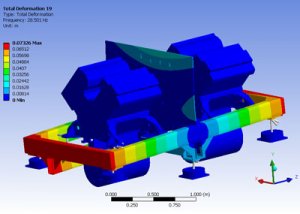
Vibration mode of twin compressors on a machinery raft
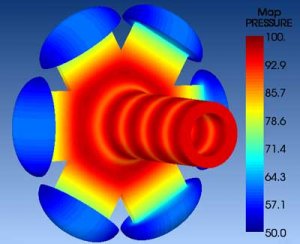
Wave propagation down the bypass duct of a fan test rig
We provide a comprehensive service to predict and optimise a wide range of engineering design problems, covering most aspects of noise and vibration control, dynamics and physical acoustics. Where appropriate we use industry standard numerical modelling codes, but have the knowledge and expertise to develop bespoke analytical or semi-empirical models as required. These capabilities are greatly enhanced by our expertise in testing and model validation which help with interpretation and physical insight. Our services include prediction capabilities for:
- Dynamic response of machinery due to internal and external forces
- Design of machinery foundations and isolation systems
- Transmission of structure-borne noise
- Design of electro-acoustic systems
- Optimisation of absorptive and reactive silencers and noise barriers
- Propagation of airborne, waterborne and groundborne noise
- Flow-induced noise and vibration
- Environmental noise mapping
Methods
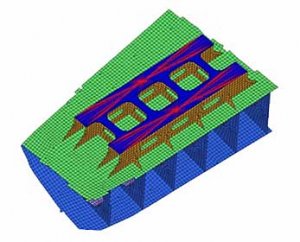
FE mesh of the machinery foundations of a 50 metre yacht
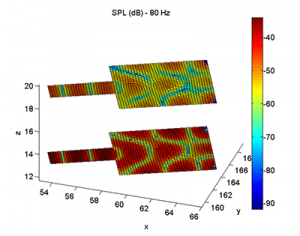
BE prediction of standing waves in an apartment
Many problems in acoustics and dynamics can be solved using well-established analytical methods and standards. For more complex and demanding tasks, we use a wide range of tools, including Finite Element (FE) and Boundary Element (BE) numerical models, and bespoke models for specific problems.
- FE modelling of structures to predict vibration and structure-borne noise
- FE modelling in acoustics, vibroacoustics and aeroacoustics to predict sound radiation, attenuation, diffraction and scattering
- Models of ground-borne vibration, sound radiation and track design for railways
- Computational Fluid Dynamics (CFD) and acoustic modelling for ducts and silencers
- BE modelling of sound radiation into large acoustic spaces
- Modelling of electro-acoustic, electromechanical or piezo-electric transducers and sound sources
- Statistical Energy Analysis (SEA) for sound transmission through large structures up to high frequencies
- Environmental noise mapping around industrial sites and infrastructure
- Direct analytical modelling for specific problems
- Semi-empirical models to scale measured data from an existing design and predict the response of a new design
Vibration
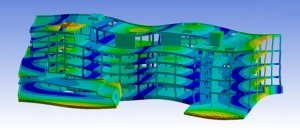
Modal response of a steel framed building with concrete floors, using Ansys FEM software
We use a range of methods and tools to model the dynamic response of structures. These models predict the natural frequencies and mode shapes, the response to internal and external forces, and, if required, the resulting stress distribution and fatigue life.
Idealised analytical models may be appropriate for simple structures, but for most real structures we use the Finite Element method, especially where a CAD model is available. Finite Element analysis is applicable to a wide range of engineering problems. Our experience includes design studies for:
- Vibration isolation of engines and pumps
- Machinery foundations and rafts in ships, cars and trains
- Design of machines and industrial plant to avoid vibration-induced resonances and misalignments
- Design of buildings requiring low vibration environments (research facilities and hospitals)
- Dynamic and static stress analysis
- Propagation of ground borne vibration
- Design of specialist test rigs and transducers
Vibroacoustics

SEA model of a tanker
Interactions between vibrating surfaces and sound fields occur in many low-noise design problems, including transmission of structure-borne noise in ships and cars and the transmission sound through the walls of ducts and buildings. At low frequencies we model sound radiation from vibrating surfaces using either acoustic Finite Element (FE) or the Boundary Element (BE) method. For transmission of higher frequency structure-borne noise we use Statistical Energy Analysis (SEA). The FE and SEA codes we use include various specialist add-on modules such as design of noise control trim materials and modelling of piezo-electric devices.
Our experience in vibrocoustics includes design studies for:
- Transmission of structure borne noise around ships, cars and trains.
- Noise radiation from ducts and enclosures due to internal noise sources and flow.
- Underwater noise radiation from ships and off-shore structures
- Response of aerospace structures to high intensity sound fields.
- Electro-acoustic design of fire alarms and other sounders
- Design of piezo-electric transducers for various applications.
Acoustics
At ISVR Consulting, we have experience in analysing a wide range of acoustics problems, and have the modelling tools to support our expertise. While simple analytical methods are adequate for solving some problems, others demand advanced computer simulations using Finite Element and Boundary element codes. For these, we use industry standard software, as well as code developed in-house, and we can use one of the fastest academic supercomputers in the UK, ‘Iridis’ , at the University of Southampton.
Applications for our acoustics modelling include:
- Design of absorptive silencers for aerospace, test facilities and HVAC systems, including the effect of flow
- Design of reactive silencers for motor vehicles, generators, etc, including the effect of flow and back pressure
- Sound radiation from ductwork (e.g. intake and exhaust ducts for aircraft, ships and cars)
- Semi-empirical modelling of flow and vortex-shedding noise (e.g. aircraft landing gear, railway vehicles, whistling buildings)
- Design of building interiors (e.g. auditoria, sports and conference facilities)
- Transmission of sound between rooms and enclosures
- Radiation of underwater sound from vibrating structures
- Airborne noise propagation
- Design of transducer housings and sound sources for products such as fire alarms, mobile phones and ultrasonic devices
Much of our acoustics modelling can be supplemented with experimental data obtained in our well equipped acoustic laboratories.
Environmental noise propagation, modelling and mapping
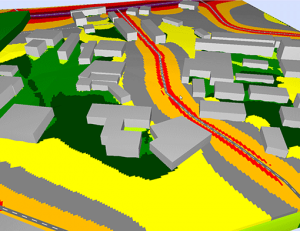
CadnaA model of the University Campus
ISVR Consulting uses the CadnaA® modelling software to predict, assess and display environmental noise radiated from roads, railways and industrial sites.
CadnaA models sound propagation. It can handle multiple noise sources and complex layouts of barriers, buildings and obstacles which may screen or reflect noise. The calculation methods and algorithms comply with national and international standards and guidelines.
We can predict and map the sound field within proposed residential and industrial developments to optimise the site layout and mitigate high noise levels, to assess the benefits of acoustic barriers and screening, or to minimise the impact of noise radiated into the surrounding area. As a simple example, the picture on the right shows the output from a CadnaA model of the Highfield Campus of the University of Southampton, based on estimated traffic flows on the surrounding roads.
This modelling approach may also be used to carry out Environmental Impact Assessments as part of larger development schemes.
Acknowledgement: CadnaA® is a registered trademark of DataKustik GmbH
Further information: Numerical modelling in acoustics, dynamics and vibroacoustics. M G Smith, Proceedings of the Institute of Acoustics 38(1) 2016, 263-271 (pdf 475 KB)

